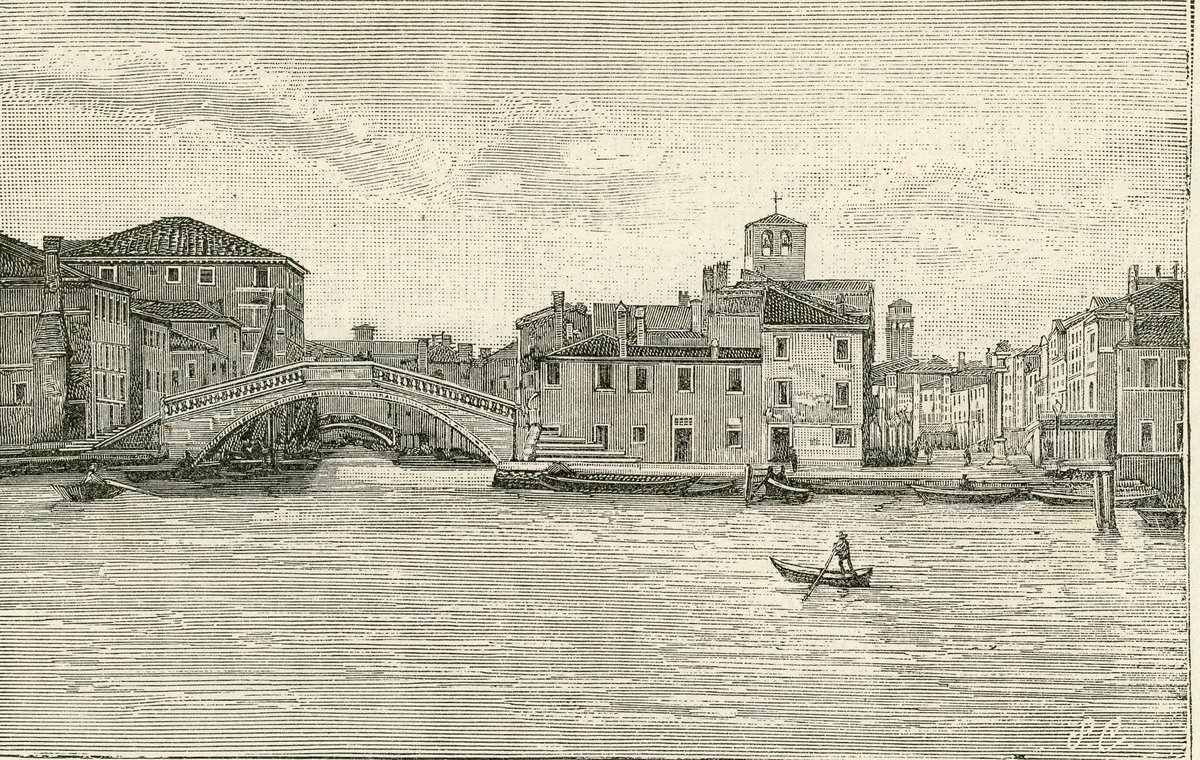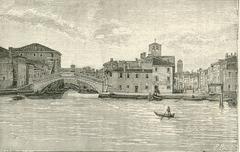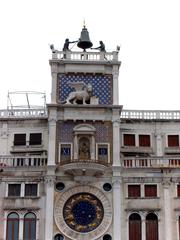
Vigo Bridge Chioggia, Italy: Visiting Hours, Tickets, and Historical Significance
Date: 14/06/2025
Introduction
Ponte Vigo (Vigo Bridge), located in the historic heart of Chioggia, Italy, is a cherished emblem of the city’s rich maritime heritage and architectural elegance. Spanning the Canal Vena, this iconic bridge connects Chioggia’s vibrant center to the waterfront, offering panoramic views of the Venetian Lagoon. With origins rooted in medieval conflicts and Renaissance artistry, Vigo Bridge stands as a symbol of resilience, civic pride, and artistic refinement. This detailed guide explores the bridge’s history, architectural features, cultural significance, practical visiting information—including hours, tickets, accessibility—and tips for making the most of your visit to this Venetian gem (Viaggiamo, Sottomarina.net).
Table of Contents
- Early Origins and Medieval Foundations
- Renaissance Rebuilding and Venetian Influence
- Symbolism and Civic Identity
- Modern History and Restoration
- Architectural Features
- Decorative Elements and Symbolism
- Visitor Information (Hours, Tickets, Accessibility)
- Getting There and Travel Tips
- Nearby Attractions
- Special Events and Community Life
- Photographic Opportunities
- Frequently Asked Questions (FAQ)
- Summary and Final Tips
- References
Early Origins and Medieval Foundations
Vigo Bridge’s origins trace back to at least 1379, during the War of Chioggia, when the strategic crossing was first built in wood as part of the city’s defense against Genoese forces. Its location at the southern end of the Canal Vena made it a vital point for military and commercial activities (Viaggiamo). After the war, the bridge was restored and maintained, reflecting its ongoing importance in daily life and urban development.
Renaissance Rebuilding and Venetian Influence
In the late 15th century, as Chioggia flourished under Venetian rule, Vigo Bridge underwent significant transformation. The present stone structure—primarily built of resilient Istrian limestone—was completed in 1685, replacing the earlier wooden version (Sottomarina.net). Later enhancements in the 18th century added ornate marble balustrades and decorative elements, cementing the bridge’s status as an architectural highlight and a testament to Venetian artistry (Atlas Obscura, Visit Chioggia).
Symbolism and Civic Identity
By the 18th century, Ponte Vigo had evolved into a symbol of Chioggia’s resilience and civic identity. Its strategic position at the end of Corso del Popolo—the city’s main thoroughfare—turned it into a “balcony” over the lagoon, offering gathering spaces for residents and visitors alike (Viaggiamo). The bridge’s architectural beauty and cultural significance have earned it comparisons to Venice’s Rialto Bridge, though it remains more intimate and authentic in atmosphere.
Modern History and Restoration
Despite political changes and modernization—from the fall of the Venetian Republic to industrial expansion—Vigo Bridge has endured as a steadfast civic landmark. Regular restorations have preserved its historic character, ensuring the stonework and decorative details remain true to their original design (Images of Venice). Today, the bridge is celebrated not only for its history but also for its role as a vibrant public space.
Architectural Features
Vigo Bridge is distinguished by a single, elegant stone arch and finely carved marble balustrades, which lend both structural integrity and visual refinement (Sottomarina.net). The use of Istrian stone, renowned for its durability and pale luminosity, links the bridge aesthetically to Venetian architecture (Visit Chioggia). The bridge’s broad steps and gentle slope make it accessible for most pedestrians.
Decorative Elements and Symbolism
Guarding each approach are four imposing stone lions, symbols of the Venetian Republic’s power and protection (JustInPlusLauren). The nearby Vigo Column, topped by a small lion affectionately called “el gatòn” (“Chioggia’s Cat”), adds a touch of local humor and folklore (Visit Chioggia). The balustrades feature intricate carvings, including coats of arms commemorating the city’s governance.
Visitor Information: Hours, Tickets, Accessibility
- Visiting Hours: Open to the public 24/7, year-round. No restricted hours.
- Tickets: No entrance fees or tickets required—completely free.
- Accessibility: The bridge is pedestrian-only. Broad steps and a gentle slope make it accessible for most, but wheelchair users may need assistance (Evendo).
- Best Times to Visit: Early mornings or sunsets for optimal lighting and fewer crowds; spring and autumn for mild weather (Wanderlog).
Getting There and Travel Tips
- Location: Northern end of Corso del Popolo, in Piazzetta Vigo, overlooking the lagoon.
- By Car: Park outside the historic center and walk (10–15 minutes).
- By Public Transport: Buses connect Chioggia to Venice, Mestre, and Padua; trains arrive at Chioggia station.
- By Ferry: Vaporetti and private boats depart from Piazzetta Vigo to Venice, Pellestrina, and the Lido (Mama Loves Italy).
- Proximity to Amenities: Numerous cafes, osterie, shops, and public restrooms are nearby.
Nearby Attractions
- Piazzetta Vigo & Vigo Column: The social heart of Chioggia, with cafes and markets.
- Corso del Popolo: Main avenue lined with shops and historic buildings.
- Fish Market (Pescheria): Bustling, authentic local experience.
- Museo Civico della Laguna Sud: Maritime and lagoon history (Italian Chapter).
- Cathedral of St Mary of the Assumption and Basilica of St James the Apostle: Notable religious sites.
Special Events and Community Life
Ponte Vigo and its piazza are central to Chioggia’s vibrant social and cultural life. Annual festivals such as the Palio della Marciliana and Sagra del Pesce transform the area with parades, medieval reenactments, food stalls, and music (Images of Venice, Mama Loves Italy). The bridge is also a favorite spot for evening passeggiatas and waterfront aperitifs.
Photographic Opportunities
Vigo Bridge is one of Chioggia’s most photogenic sites, offering panoramic views of the canal, lagoon, and surrounding historic architecture (Bonjour Venise). Sunrise and sunset provide exceptional lighting for capturing the bridge’s marble details and colorful reflections on the water (European Waterways). It is a popular location for both amateur photographers and filmmakers.
Frequently Asked Questions (FAQ)
Q: What are Vigo Bridge visiting hours?
A: The bridge is open 24/7, all year round.
Q: Do I need tickets to visit Vigo Bridge?
A: No, it is free to access at any time.
Q: Is Vigo Bridge wheelchair accessible?
A: The gentle slope and broad steps are manageable for most, but there are steps—wheelchair users may need assistance.
Q: Are there guided tours available?
A: Yes, guided walking and boat tours of Chioggia often include Vigo Bridge. Check with local tourism offices.
Q: What are the best times for photography?
A: Early morning and sunset provide the best light and atmosphere.
Summary and Final Tips
Ponte Vigo stands as a living monument to Chioggia’s centuries-old spirit, blending history, artistry, and community life. Open to all with no fees or time restrictions, it offers a welcoming gateway to the city’s historic core and lagoon. With its striking Istrian stone, elegant balustrades, and symbolic stone lions, the bridge rivals Venice’s Rialto in beauty but provides a more intimate, authentic experience (Atlas Obscura, Viaggiamo). Its central location, accessibility, and proximity to key attractions make it an essential stop for any visitor to Chioggia.
Plan your visit today, and for up-to-date information, guided tours, and insider tips, download the Audiala app. Stay connected through social media and explore our related articles to deepen your appreciation of Chioggia’s enchanting heritage.
References
- Viaggiamo: Ponte Vigo in Chioggia
- Sottomarina.net: Vigo Bridge
- Atlas Obscura: Vigo Bridge
- Visit Chioggia: Historical Old Town
- Mama Loves Italy: Chioggia
- Italian Chapter: Chioggia
- Images of Venice: Discover Chioggia
- Affitti Brevi Veneto: What to See in Chioggia
- European Waterways: Visiting Chioggia
- Bonjour Venise: Chioggia
- Lidi di Chioggia: Il Ponte di Vigo
- Evendo: Vigo Bridge
- Wanderlog: Explore Chioggia
- JustInPlusLauren: Chioggia
For a richer experience, explore our interactive maps, photo galleries, and related articles on Chioggia’s historical sites and Venetian heritage. All external links above lead to authoritative references as required.


